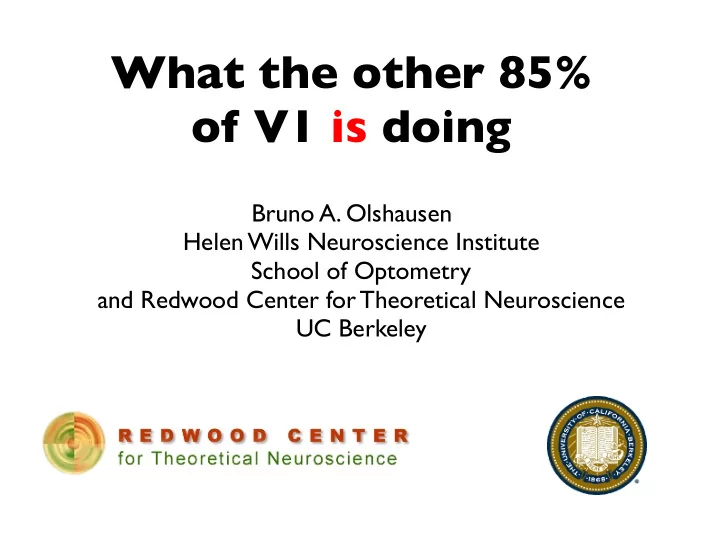

What the other 85% of V1 is doing Bruno A. Olshausen Helen Wills Neuroscience Institute School of Optometry and Redwood Center for Theoretical Neuroscience UC Berkeley
The “standard model” of V1 R e s p ons e P o i n t w i s e R e s p ons e Image R e c e ptiv e fi e ld nor ma li z a ti on non - li n ea r it y li n ea r - r e s p ons e + - or / r ( t ) I ( x , y , t ) - K ( x , y , t ) n e i g hb or i n g n e u rons
Why I am skeptical of the standard model • Lessons from the retina • Lessons from invertebrates • Vast overcompleteness of V1 • Non-linearities of cortical neurons • Difficulty of predicting neural responses to time-varying natural images
Lessons from the retina
On vs. off cone bipolar cells
Rod bipolar cell is of on-type only Net convergence of rods to bipolar cells
AII amacrine cell links rod bipolar cells to ganglion cells
Lessons from invertebrates
Jumping spiders
Jumping spiders
Vast overcompleteness of V1
1 mm 2 of cortex analyzes ca. 14 x 14 array of retinal sample nodes and contains 100,000 neurons
V1 output is overcomplete by a factor of 50:1 70 μ Parvo cell input fibers V1 output fibers (layer 2/3)
Non-linearities of cortical neurons
Hausser & Mel (2003) (a) (b) 2-Layer model � i Thin branch y 1 subunits (c) 3-Layer model � i Distal apical thin branches y 2 � j Perisomatic thin branches Current Opinion in Neurobiology
Difficulty of predicting V1 neural responses to time-varying natural images
Responses of V1 neurons are not well predicted by RF models 18 ms 53 ms 88 ms 123 ms 159 ms 194 ms 229 ms 264 ms receptive field: a219, group 3, cell 4 ρ =0.362 0.8 0.7 spike count (35 msec bins) 0.6 0.5 0.4 0.3 0.2 0.1 0 0 5 10 15 20 25 30 time (sec)
Responses of neighboring cells are heterogeneous cell 1 30 20 10 0 0 5 10 15 20 25 30 cell 2 30 20 10 0 0 5 10 15 20 25 30 cell 3 30 spikes/sec 20 10 0 0 5 10 15 20 25 30 time (sec)
What is the other 85% doing? 1. 0 Va ri a nce e x pl a ined ~ 0 . 4 ~85% of V 1 function not understood 0 . 3- 0 . 4 0 0 1. 0 Proportion of cells studied
There’s hope.
Silicon polytrodes (Swindale, Blanche, Spacek)
What to look for • What does a “day in the life of V1” look like? • Explaining away (sparsification) • Phase • Figure-ground • Synchrony • Laminar distribution of function (microcircuit)
Explaining away Sparsified Feedforward response ( $# ) response ( "# ) ! ! ! ! ! ! ! ! ! !
Phase Iris recognition (Daugman) Phase-Quadrant Demodulation Code Im [0, 1] [1, 1] Re [0, 0] [1, 0] Figure 2: The phase demodulation process used to
Time-varying phase encodes information about transformations amplitude phase coefficient index time time
Modeling phase dependencies (Charles Cadieu) sparse
Learned D (space domain)
Learned D (frequency domain)
Learned D
Figure-ground
V1 simple cells can represent amodal completion Sugita (1999)
Synchrony LGN spikes are phase-locked to ongoing retinal oscillations (Koepsell, Sommer, Hirsch)
Distribution of function across laminae
The Unknown As we know, There are known knowns. There are things we know we know. We also know There are known unknowns. That is to say We know there are some things We do not know. But there are also unknown unknowns, The ones we don't know We don't know. Feb. 12, 2002, Department of Defense news briefing From: The Poetry of Donald Rumsfeld Hart Seeley, Slate Magazine
Recommend
More recommend